First Atlantic Nickel Announces Expanded 4-Kilometer Strike Length at RPM Zone from DTR Surface Sampling at Pipestone XL Nickel Alloy Project
GRAND FALLS-WINDSOR, Newfoundland and Labrador, Oct. 21, 2025 (GLOBE NEWSWIRE) -- First Atlantic Nickel Corp. (TSX-V: FAN) (OTCQB: FANCF) (FSE: P21) ("First Atlantic" or the "Company") is pleased to report that recent Davis Tube Recovery (DTR) surface sampling and geological mapping has successfully expanded the RPM Zone target area to a continuous 4-kilometer strike length within the 30-kilometer nickel trend at its Pipestone XL Nickel Alloy Project in central Newfoundland. The new results extend the known mineralization footprint approximately 2 kilometers north of the previously defined 2-kilometer drill-defined RPM Zone, where 800 meters of drilling has already confirmed awaruite mineralization over a north-south strike length. This newly identified northern extension, designated Exploration Priority 1 (See Figure 1), demonstrates continuity of awaruite nickel mineralization based on DTR surface sampling and detailed geological mapping.
The surface sampling program has returned consistent, positive magnetically recoverable DTR nickel values over a larger area than previously outlined. DTR Surface sample results from the northern extension (Figure 1 - Exploration Priority 1 Area) are comparable to those from the initial RPM discovery area, where drill holes AN-24-05 and AN-25-06 returned an average DTR grade of 0.12% magnetically recoverable nickel in drill core. Integration of surface sampling, improved geological mapping, and Phase 2X drilling has refined the geological model and identified a westward-dipping body of awaruite nickel mineralization. Based on this understanding, future drilling at the Pipestone XL Nickel Project will target eastward to cross the true width of the mineralized zone. This approach will be applied across the project including at the RPM Zone extension and the Super Gulp Zone (~10 kilometers north of the RPM Zone discovery), where it will correct prior westward drilling that failed to optimally test the westward-dipping awaruite structure.
HIGHLIGHTS:
-
4-Kilometer Strike Length Outlined at RPM Zone: Surface DTR sampling and geological mapping have outlined continuous mineralization creating a 4 km target area at the RPM Zone (RPM, RPM North, and RPM South). This target area combines the previously defined 2 km drill target area with a 2 km north-south extension.
-
Southern RPM Extension Discovered: Areas previously mapped southeast of the RPM Zone as submarine mafic to felsic volcanics have now been confirmed as ultramafic peridotites. DTR sampling from small islands outcropping in shallow water cover in Pipestone Pond returned positive results, extending awaruite mineralization approximately ~1 km south of the RPM Zone.
-
Westward-Dipping District Structure Defined: Phase 2X drilling and mapping have delineated a westward-dipping ultramafic structure hosting awaruite nickel mineralization within serpentinized peridotite. Future drilling will be oriented eastward to drill across the mineralized body.
-
Regional Deformation Zone Identified: Interpretation of a northeast-southwest trending deformation structure beneath Pipestone Pond provides a new structural framework and opens additional exploration opportunities for both north-south strike extensions and further expansion westward of Pipestone Pond.
-
Western Sampling Increases RPM Zone Target Width: Positive DTR results west of Pipestone Pond expand the RPM Zone potential width to ~1.2 kilometers, significantly broader than the 750-meter width currently defined in Section 2.
-
DTR Surface Sampling Proves Effective: Surface sampling remains a reliable method for drill targeting, with drill cores typically yielding DTR nickel grades multiple times higher than weathered surface samples.
-
Super Gulp: Company geologists have completed additional mapping and sampling at Super Gulp (~10 kilometers north of the RPM Zone). Future eastward-oriented drilling is planned to retest the target area.
-
Phase 2X Assay & DTR Drill Results: Additional whole rock assay and DTR Results from Phase 2X drill core are anticipated over the coming weeks.
For further information, questions, or investor inquiries, please contact Rob Guzman at First Atlantic Nickel by phone at +1-844-592-6337 or via email at rob@fanickel.com
NORTHERN EXTENSION - INCREASES RPM ZONE STRIKE LENGTH TO 4 KILOMETERS
The Company's systematic DTR surface sampling program has successfully doubled the strike length of the RPM Zone target area to approximately 4 kilometers. The existing, well-defined drill target area spans ~2 kilometers north-south, where drilling has confirmed awaruite mineralization over 800 meters to date. Recent DTR surface sampling and geological mapping have outlined an additional ~2 kilometers of continuous mineralization further north, now designated as Exploration Priority 1 (See Figure 1), with magnetically recoverable nickel grades comparable to those from the initial RPM Zone Discovery Area. This creates a continuous 4-kilometer target zone along strike throughout the RPM Zone.
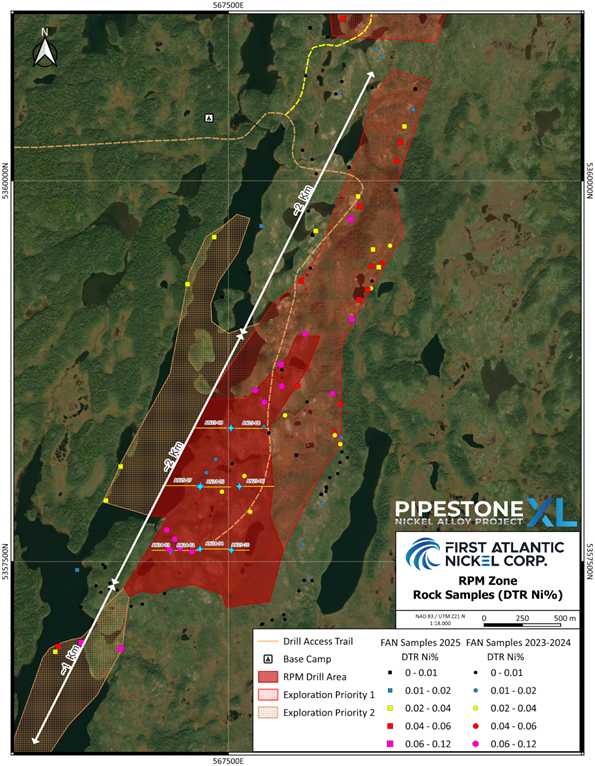
Figure 1: RPM Zone Area Map with Surface Sample DTR Nickel Results Outlining Larger Target Areas.
SOUTHERN EXTENSION - NEW DISCOVERY IN PREVIOUSLY MISIDENTIFIED ROCK UNITS
Surface sampling has identified a ~1-kilometer southern extension of the RPM Zone in areas that were previously mapped as submarine mafic to felsic volcanics. Company geologists have now reclassified these units as ultramafic peridotites hosting awaruite mineralization. The sampling program tested small islands and outcrops in and around shallow water cover in Pipestone Pond, where positive DTR results, comparable to those from the main RPM Zone, highlight the potential for additional mineralization. This newly defined area has been designated as Exploration Priority 2 (See Figure 1).
EXPANSION POTENTIAL WEST OF PIPESTONE POND
Positive DTR results from peridotite outcrops west of Pipestone Pond have expanded the potential RPM target width to approximately 1.2 kilometers, compared to the ~750-meters currently drill-defined on line Section S2 (Holes AN-24-05 to AN-25-07) (See Figure 2). Surface samples from this western area returned positive magnetically recoverable nickel values comparable to surface results near hole AN-24-05, which intersected 351 meters grading 0.12% magnetically recoverable nickel in drilling. These results demonstrate the potential for westward expansion of the RPM Zone into areas beneath and west of Pipestone Pond that have not yet been drill tested.
STRUCTURAL INTERPRETATION - WESTWARD-DIPPING STRUCTURE DEFINED
Phase 2X drilling has provided a major advancement in understanding the geometry of the ultramafic body hosting awaruite mineralization. The data indicates that the harzburgite-dominant peridotite unit dips steeply to the west, meaning that eastward-orientated drilling will be required to effectively test the true width of the mineralized awaruite body. Previous drilling orientated westward, including the single hole at Super Gulp, may have followed along mineralized layers or lower-grade halos rather than intersecting them perpendicularly. This refined structural model will significantly improve the effectiveness of future drilling, ensuring holes cross-cut the mineralized awaruite body.
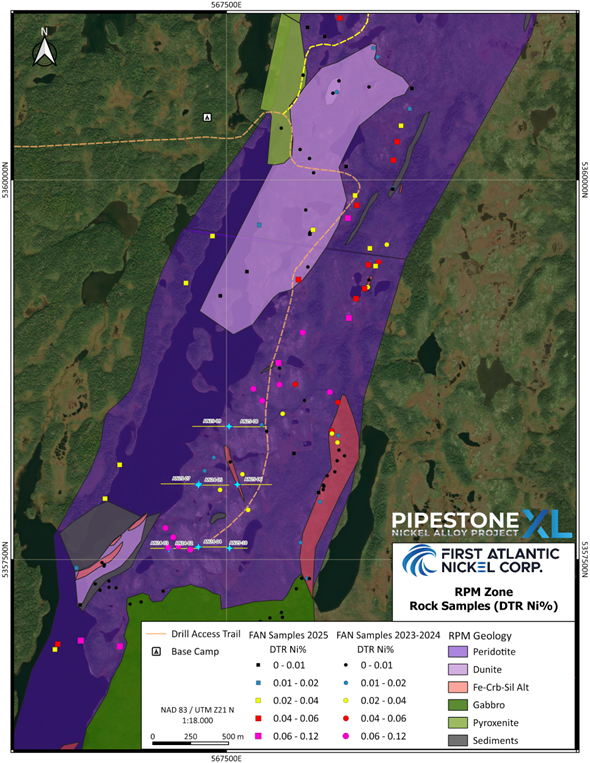
Figure 2: RPM Zone Area Geology Map with Surface Sample DTR Nickel Results Outlining Larger Target Areas.
REGIONAL DEFORMATION STRUCTURE UNDER PIPESTONE POND
Company geologists have interpreted a large regional deformation structure trending northeast-southwest throughout the Pipestone Ophiolite Complex. This fault-controlled structure, which lies beneath shallow water cover in Pipestone Pond, has incorporated small blocks or wedges of sediments into contact with the larger ultramafic units through intense faulting. The deformation zone is positioned beneath Pipestone Pond.
This structure represents a compelling opportunity for expansion, as fault structures within this zone could develop areas of concentrated nickel mineralization due to increased fluid flow. This enhanced fluid circulation promotes serpentinization, a critical process necessary for the formation of awaruite nickel alloy. Positive DTR samples delineate the western shore of Pipestone Pond as a 1.8-kilometer-long target area (See Figure 2). With the new interpretation of the westward-dipping structure, eastward-oriented drill holes collared from the western shore of Pipestone Pond are expected to test both the deformation zone and the underlying awaruite-enriched RPM structure, providing an opportunity to significantly expand the interpreted width of the mineralized system.
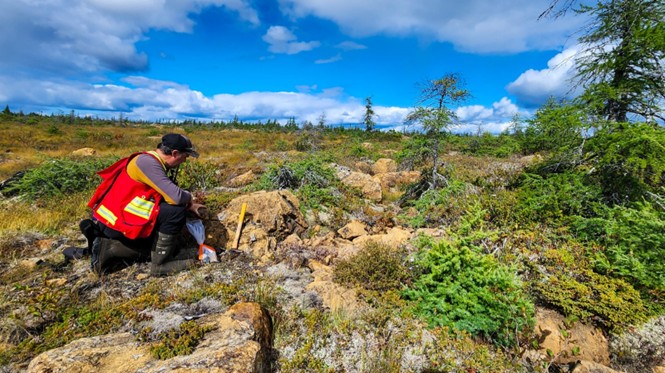
Figure 3: Project Geologist Mike Piller collecting DTR surface samples at Pipestone XL Nickel Alloy Project.
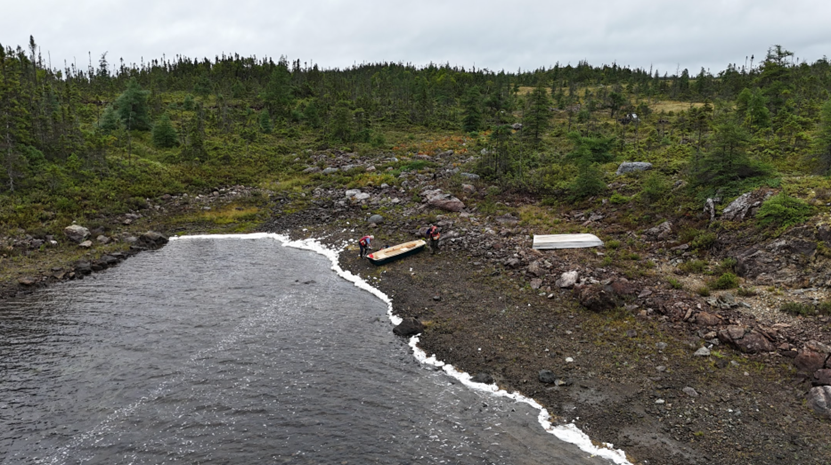
Figure 4: Surface sampling west of Pipestone Pond, where awaruite-bearing peridotite samples returned positive DTR nickel values similar to the RPM Zone.
Table 1: Pipestone XL Project - RPM Zone Additional Phase 2X Drill Results Pending
| Drill Hole | Zone | Section | From meters | To meters | Interval meters |
Magnetically Recovered (DTR) Nickel % |
Magnetic Concentrate Nickel Grade (Ni %) |
Mass Pull (%) |
Comment |
| AN 24 - 02 | RPM | S1 | 11.0 | 394.1 | 383.1 | 0.13 | 1.37 | 9.50 | NR - March 12, 2025 |
| AN 24 - 03 | RPM | S1 | 18.0 | 234.0 | 216.0 | 0.11 | 1.32 | 9.12 | NR - April 15, 2025 |
| AN 24 - 04 | RPM | S1 | 12.0 | 378.0 | 366.0 | 0.14 | 1.46 | 9.53 | NR- June 24, 2025 |
| AN 24 - 05 | RPM | S2 | 6.0 | 357.0 | 351.0 | 0.12 | 1.47 | 8.21 | NR - July 9, 2025 |
| AN 25 - 06 | RPM | S2 | 5.65 | 453 | 447.35 | 0.11 | 1.27 | 9.02 | NR - August 12, 2025 |
| AN 25 - 07 | RPM | S2 | 495.0 | pending | pending | Awaruite - Visibly Disseminated | |||
| AN 25 - 08 | RPM | S3 | 491.0 | pending | pending | Awaruite - Visibly Disseminated | |||
| AN 25 - 09 | RPM | S3 | 480.0 | pending | pending | pending | |||
| AN 25 - 10 | RPM | S1 | 233.0 | pending | pending | pending |
AWARUITE - RARE & PURE NATURAL NICKEL-IRON-COBALT ALLOY MINERAL
The sulfur-free nature of awaruite (Ni3Fe), a naturally occurring nickel-iron-cobalt alloy already in metallic form, eliminates the need for secondary processes such as smelting, roasting or acid leaching that are typical of sulfide or laterite nickel ores. Unlike sulfides, which are not natural alloys, awaruite avoids the challenge of sourcing smelter capacity - a bottleneck in North America's nickel supply chain. With an average nickel grade of approximately 76%, awaruite significantly exceeds the ~25%1 nickel grade characteristic of pentlandite. Awaruite's strong magnetic properties enable concentration through magnetic separation, as demonstrated by Davis Tube Recovery (DTR) testing at First Atlantic's RPM Zone drill core.
Awaruite eliminates the electricity requirements, emissions, and environmental impacts associated with conventional smelting, roasting or acid leaching processes of common nickel minerals. Moreover, awaruite's sulfur-free composition removes the risks of acid mine drainage (AMD) and related permitting challenges commonly posed by sulfide minerals2. As noted by the United States Geological Survey (USGS) in 2012: "The development of awaruite deposits in other parts of Canada may help alleviate any prolonged shortage of nickel concentrate. Awaruite, a natural iron-nickel alloy, is much easier to concentrate than pentlandite, the principal sulfide of nickel."
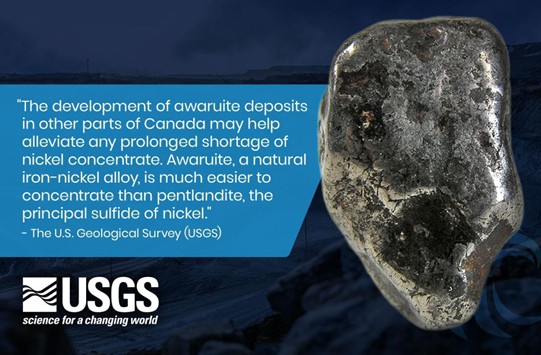
Figure 5: Quote from USGS on Awaruite Deposits in Canada
INVESTOR INFORMATION
The Company's common shares trade on the TSX Venture Exchange under the symbol "FAN", the American OTCQB Exchange under the symbol “FANCF” and on several German exchanges, including Frankfurt and Tradegate, under the symbol "P21".
Investors can get updates about First Atlantic by signing up to receive news via email and SMS text at www.fanickel.com. Stay connected and learn more by following us on these social media platforms:
https://www.facebook.com/fanickelcorp
https://www.linkedin.com/company/firstatlanticnickel/
FOR MORE INFORMATION:
First Atlantic Investor Relations
Robert Guzman
Tel: +1 844 592 6337
rob@fanickel.com
Disclosure
Adrian Smith, P.Geo., a director and the Chief Executive Officer of the Company is a qualified person as defined by NI 43-101. The qualified person is a member in good standing of the Professional Engineers and Geoscientists Newfoundland and Labrador (PEGNL) and is a registered professional geoscientist (P.Geo.). Mr. Smith has reviewed and approved the technical information disclosed herein.
Analytical Method & QA/QC
Representative rock samples were collected in the field from outcrops or subcrop exposures, while avoiding float material. Sample locations were documented using handheld GPS units. All samples were securely sealed, labeled and shipped to Activation Laboratories Ltd. (“Actlabs”) in Ancaster, Ontario, an ISO 17025 certified and accredited laboratory operating independently of First Atlantic.
Each sample was crushed, with a 250 g sub-sample pulverized to 95% passing 200 mesh. A magnetic separation was then generated by running the pulverized sub-sample through a magnetic separator which splits the sub-sample into magnetic and non-magnetic fractions. This involves running a 30 g split of the pulp through a Davis Tube magnetic separator as a slurry using a constant flow rate, a magnetic field strength of 3,500 Gauss, and a tube angle of 45 degrees to produce magnetic and non-magnetic fractions.
The magnetic fractions are collected, dried, weighed and fused using a lithium metaborate/tetraborate flux with a lithium bromide releasing agent, then analyzed on a wavelength dispersive XRF for multiple elements including nickel, cobalt, iron and chromium. The magnetically recoverable nickel grade was calculated by multiplying the XRF fusion nickel value by the weight of the magnetic fraction and dividing by the total recorded feed weight or magnetic mass pulled from the sample.
The Company’s quality assurance/quality control (QA/QC) protocol included the insertion of blanks, duplicates, and certified reference material (standards), to monitor the precision and accuracy of the laboratory results. All analytical results successfully passed QA/QC screening at the laboratory. All QA/QC protocols were performed by Actlabs. The Davis Tube Recovery (“DTR”) method described above is a bench scale metallurgical test used to measure the magnetically recoverable nickel (“DTR Ni %”).
About First Atlantic Nickel Corp.
First Atlantic Nickel Corp. (TSXV: FAN) (OTCQB: FANCF) (FSE: P21) is a critical mineral exploration company in Newfoundland & Labrador developing the Pipestone XL Nickel Alloy Project (formerly the Atlantic Nickel Project). The project spans the entire 30-kilometer Pipestone Ophiolite Complex, where multiple zones, including RPM, Super Gulp, Atlantic Lake, and Chrome Pond, contain awaruite (Ni₃Fe), a naturally occurring magnetic nickel-iron-cobalt alloy of approximately ~75% nickel with no-sulfur and no-sulfides, along with secondary chromium mineralization. Awaruite's sulfur-free composition removes acid mine drainage (AMD) risks, while its unique magnetic properties enable processing through magnetic separation, eliminating the electricity requirements, emissions, and environmental impacts of conventional smelting, roasting, or high-pressure acid leaching while reducing dependence on overseas nickel processing infrastructure.
The U.S. Geological Survey recognized awaruite's strategic importance in its 2012 Annual Report on Nickel, noting that these deposits may help alleviate prolonged nickel concentrate shortages since the natural alloy is much easier to concentrate than typical nickel sulfides3. The Pipestone XL Nickel Alloy Project is located near existing infrastructure with year-round road access and proximity to hydroelectric power. These features provide favorable logistics for exploration and future development, strengthening First Atlantic’s role to establish a secure and reliable source of North American nickel production for the stainless steel, electric vehicle, aerospace, and defense industries. This mission gained importance when the US added nickel to its critical minerals list in 20224, recognizing it as a non-fuel mineral essential to economic and national security with a supply chain vulnerable to disruption.
Neither the TSX Venture Exchange nor its Regulation Services Provider (as that term is defined in policies of the TSX Venture Exchange) accepts responsibility for the adequacy or accuracy of this release.
Forward-looking statements:
This news release may include "forward-looking information" under applicable Canadian securities legislation. Such forward-looking information reflects management's current beliefs and are based on a number of estimates and/or assumptions made by and information currently available to the Company that, while considered reasonable, are subject to known and unknown risks, uncertainties, and other factors that may cause the actual results and future events to differ materially from those expressed or implied by such forward-looking information.
Forward-looking information in this news release includes, but is not limited to: statements regarding: the timing, scope and results of the Company’s Phase 1 and Phase 2X drilling programs; future project developments; the Company’s objectives, goals, and future plans; statements and estimates of market conditions; the viability of magnetic separation as a low-impact processing method for awaruite; the strategic and economic implications of the Company’s projects; and expectations regarding future developments and strategic plans. Readers are cautioned that such forward-looking information are neither promises nor guarantees and are subject to known and unknown risks and uncertainties including, but not limited to, general business, economic, competitive, political and social uncertainties, uncertain and volatile equity and capital markets, lack of available capital, actual results of exploration activities, environmental risks, future prices of base and other metals, operating risks, accidents, labour issues, delays in obtaining governmental approvals and permits, and other risks in the mining and clean energy industries. Additional factors and risks including various risk factors discussed in the Company’s disclosure documents which can be found under the Company’s profile on http://www.sedarplus.ca. Should one or more of these risks or uncertainties materialize, or should assumptions underlying the forward-looking statements prove incorrect, actual results may vary materially from those described herein as intended, planned, anticipated, believed, estimated or expected.
The Company is presently an exploration stage company. Exploration is highly speculative in nature, involves many risks, requires substantial expenditures, and may not result in the discovery of mineral deposits that can be mined profitably. Furthermore, the Company currently has no mineral reserves on any of its properties. As a result, there can be no assurance that such forward-looking statements will prove to be accurate, and actual results and future events could differ materially from those anticipated in such statements. The Company undertakes no obligation to update forward-looking information, except as required by applicable securities laws.
_________________________________
1 https://fpxnickel.com/projects-overview/what-is-awaruite/
2 https://d9-wret.s3.us-west-2.amazonaws.com/assets/palladium/production/mineral-pubs/nickel/mcs-2012-nicke.pdf
3 https://d9-wret.s3.us-west-2.amazonaws.com/assets/palladium/production/mineral-pubs/nickel/mcs-2012-nicke.pdf
4 https://www.usgs.gov/news/national-news-release/us-geological-survey-releases-2022-list-critical-minerals
Photos accompanying this announcement are available at:
https://www.globenewswire.com/NewsRoom/AttachmentNg/543526ca-917a-44f3-ad20-ff5da73c9d5c
https://www.globenewswire.com/NewsRoom/AttachmentNg/20a1701d-8fd0-4723-a810-1c3ce9c30842
https://www.globenewswire.com/NewsRoom/AttachmentNg/7818f39e-a3bf-40ff-b46b-3676ac2a1740
https://www.globenewswire.com/NewsRoom/AttachmentNg/0b35c9ff-5c2e-46aa-a828-06fdb27004b8
https://www.globenewswire.com/NewsRoom/AttachmentNg/d1f6ff87-0134-46e0-b88e-7b0778f9e83b

Figure 1
RPM Zone Area Map with Surface Sample DTR Nickel Results Outlining Larger Target Areas.
Figure 2
RPM Zone Area Geology Map with Surface Sample DTR Nickel Results Outlining Larger Target Areas.
Figure 3
Project Geologist Mike Piller collecting DTR surface samples at Pipestone XL Nickel Alloy Project.
Figure 4
Surface sampling west of Pipestone Pond, where awaruite-bearing peridotite samples returned positive DTR nickel values similar to the RPM Zone.
Figure 5
Quote from USGS on Awaruite Deposits in Canada
Legal Disclaimer:
EIN Presswire provides this news content "as is" without warranty of any kind. We do not accept any responsibility or liability for the accuracy, content, images, videos, licenses, completeness, legality, or reliability of the information contained in this article. If you have any complaints or copyright issues related to this article, kindly contact the author above.





